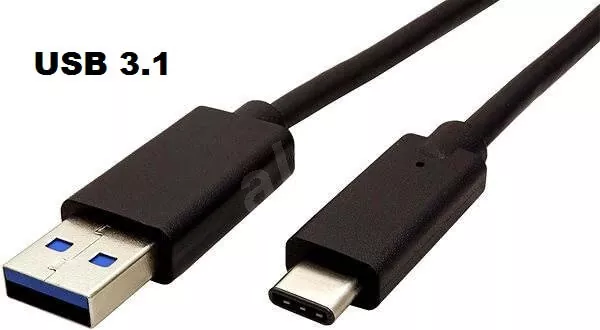A new USB that supports speeds of up to 10GBbps is ready to start taking over from our ubiquitous USB. The appearance of Apple’s Lightning connector and the many improvements our usual USB had to undergo in order to remain the “Universal” reference interface have resulted in this new specification, USB 3.1
USB 3.1, the improvements
USB 3.1 is backward compatible, that means it accepts USB 3.0, 2.0 and 1.0 devices.
Ability to supply power negotiated: The USB 2.0 supported 0.5 Amps maximum. USB3.1 supports 0.9Amps, and can negotiate supply 1.5Amps and up to 3Amps in installations that support it (cable, connectors, etc).
Speed increased up to 10Gbps, compared to 5 for USB 3.0, and 480Mbps for USB 2.0.
Appearance of the type C connector
USB 3.1, Type-C connector
The USB 3.1 brings a new connector, small like the MicroUSB, with more pins, and that by means of an adapter cable allows to connect common USB 3.0 and USB 2.0 devices.
The added pins correspond to the USB 3.0 port built into the USB 3.1, the new high-speed USB 3.1 lines, and also a generous number of pins to pass a high amount of current to use high-power devices or high charging demands (to quickly charge tablets and phones, for example)
As a curiosity, we must add that the USB 3.1 connector is reversible, it can be connected in any way, we no longer have to be looking for if we are connecting it well or vice versa as happened with the USB.
Real returns
USB 3.1, 10Gbps ready. In real tests, and due to the information coding system, it has reached a real 7Gbps.
USB 3.0, 5Gbps ready. In real tests, it has reached 3.2Gbps that is about 400Megabytes per second real. Quite a staggering number.
USB 2.0 was prepared for 480Mbits, although in the best cases it only reached 280Mbits. A figure equivalent to 35Mbytes / second.
USB 1.1 was prepared for 12Mbits, something close to 1Mbyte per second in real conditions.
A Note on USB2.0 and USB3.0 Pen Drives
In the previous paragraph you could read that USB 2.0 supports sustained and proven up to about 35MBytes / s. Many people have tested USB 2.0 and 3.0 Pen Drives and found that USB 3.0 are indeed much faster. In real figures: a USB 2.0 pen drive usually reaches about 4 or 5Mbytes / s real, while USB3.0 usually arrives without problems between 8 and 14Mbytes / s.
All these figures are less than 35Mbytes / s. So the bottleneck is not in the USB 2.0 interface but in the used flash memory.
Manufacturers use slow flash memory for USB 2.0 Pen Drives, with speeds of up to 5Mbytes / s.
Manufacturers use fast memory sticks for USB 3.0 Pen Drives with speeds of up to 14Mbytes / s.
The conclusion we can draw is that, although our computer does not have USB 3.0 ports, we can take a clear advantage of using USB 3.0 Pen Drives since the memory is much faster, and the USB 2.0 port perfectly accepts these speeds.
As the driving force behind WikiPluck, I am dedicated to curating and sharing insightful knowledge across a spectrum of subjects. From technology trends to Business advice, WikiPluck strives to be a go-to resource for those seeking to enhance their understanding and make informed decisions.
Join me on this journey of discovery and enlightenment as we pluck the gems of wisdom from the vast landscape of knowledge.

